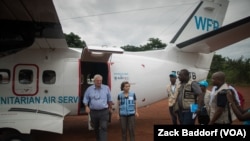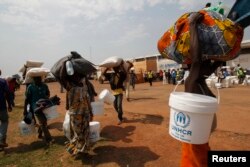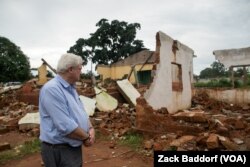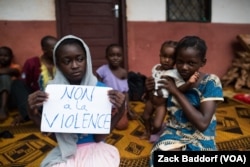Since mid-May, a series of attacks on towns throughout Central African Republic have resulted in the deaths of more than 300 people and the displacement of more than 100,000.
In the country's southeast, militias known as the anti-balaka attacked a mostly Muslim district in Bangassou in mid-May, leaving at least 100 people dead.
The United Nations' top humanitarian official, Stephen O'Brien, is visiting C.A.R. this week and says the U.N. mission is working to ensure people are protected, despite the violence.
But the violence is also rising against humanitarian workers in the countryside.
"I am very sad to say that the Central African Republic is the most dangerous place in the world to be an aid worker," O'Brien said. "Sadly, there have been a serious number of deaths and injuries to aid workers, very bravely courageously, but persistently and with great confidence and skill going about their work."
'Self-defense groups'
The U.N. humanitarian coordinator in C.A.R., Najat Rochdi, said she was focusing on making sure communities across the country were not held "hostage" by the armed groups.
"How can they call themselves 'self-defense groups'?" she asked. "Who are they defending? The population? The communities? When you loot the bases of the humanitarians who actually are supporting the communities, when you are stealing the food from the mouth of the communities, and from those who are starving, are you really protecting and defending the population? I am not sure."
In Bangassou, roughly 16 percent of the population is displaced, with about 2,000 Muslims living at the Catholic church, another 8,000 displaced elsewhere and 4,000 people seeking refugee status in the Democratic Republic of the Congo.
Issa Dafakalumba, 45, and his family now live in the camp near Bangassou's Catholic church. He said the anti-balaka burned their house.
He said living conditions were difficult and the anti-balaka were all around. He said that even going to the market was difficult.
Dafakalumba credited the U.N. peacekeeping force for keeping them safe, saying that if it weren't there, he and his fellow Muslims would be "exterminated."
Many homes gone
The U.N. humanitarian representative in Bangassou, Blaise Kabongo, said the situation was "very tense" and that many people had nowhere to return to.
"If you move around this area, in Tokoyo, you will see not only the roofs of many houses are being taken out, but also the houses themselves; the walls are being destroyed and the bricks taken away," he said. "So people are ready to come back, but they do not have security. They do not have a home to go back to."
Some residents in the Tokoyo neighborhood blame the Muslim ex-Seleka militias for starting the violence.
Christian farmer Jean Paul Basumba said things were calm, but that people were still afraid of what might come.
He said people had heard there were armed Seleka groups that would attack Bangassou. It is due to the Seleka, he said, that people have mostly left.
About 2 million people in the Central African Republic, about half the country's population, rely on humanitarian aid.


















